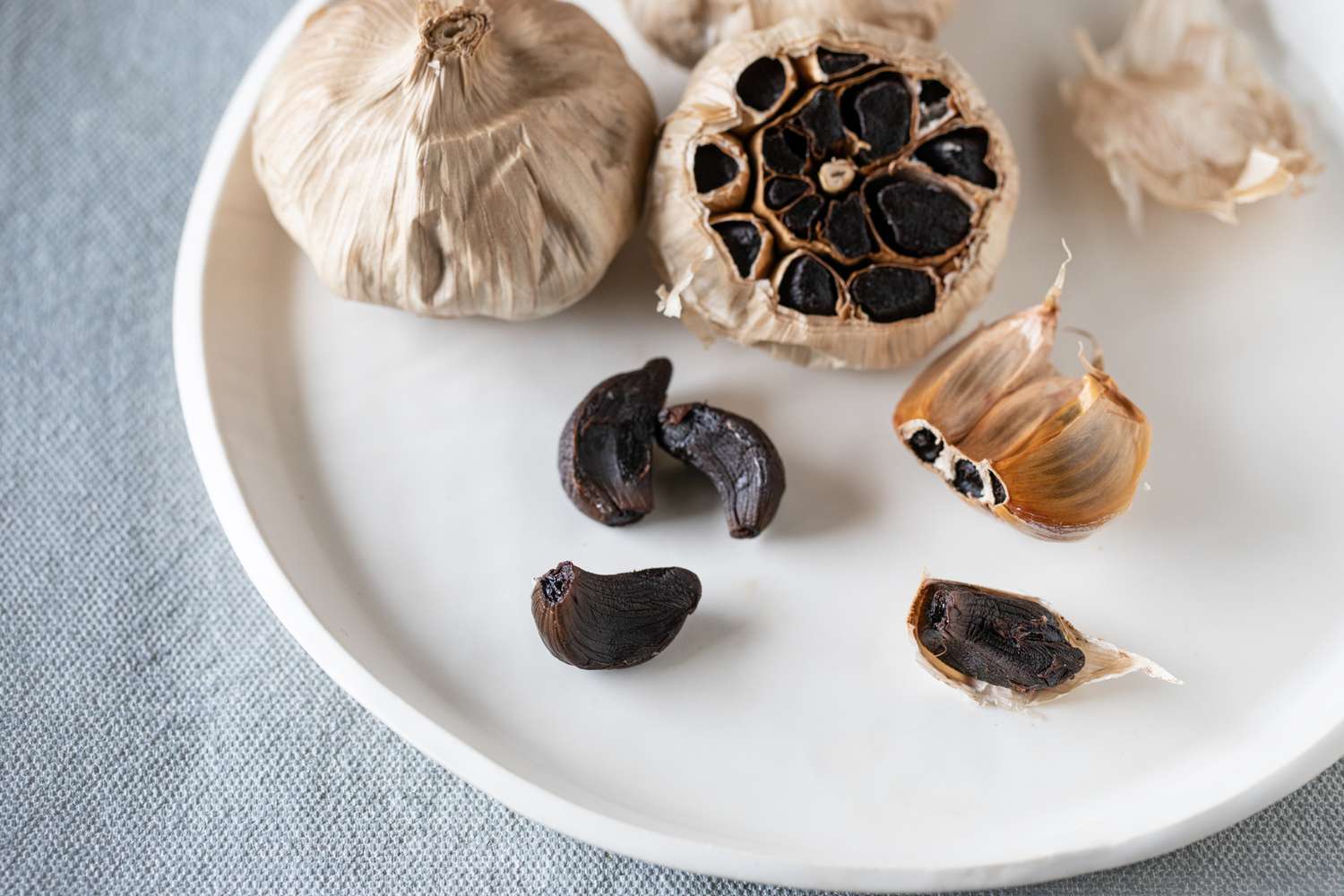When you think about ways to mellow garlic’s signature pungency, two popular methods often come to mind: roasting and aging (resulting in black garlic). Both deliver a sweeter, less abrasive form of garlic, but they’re hardly the same. Below, we’ll break down how black garlic and roasted garlic are made, how they differ in flavor and texture, and how best to use each in your cooking.
1. The Basic Processes
Roasted Garlic
-
How It’s Made: Roasted garlic is created by baking or roasting whole heads (or individual cloves) in the oven, typically at around 375–400 °F (190–200 °C) for 30–60 minutes.
-
Immediate Goal: High heat quickly softens the cloves, caramelizing some of their natural sugars.
-
Common Method: Slice off the top of the bulb, drizzle with olive oil, wrap in foil, and bake.
Black Garlic
-
How It’s Made: Black garlic results from aging fresh garlic in low heat (60–90 °C) and high humidity for several weeks—often 2 to 6 weeks.
-
Transformative Reaction: This slow, steady process triggers the Maillard reaction, creating sticky cloves with a deep brown or black hue.
-
Common Method: Professional producers use specialized equipment; home cooks sometimes try rice cookers or slow cookers.
Key Difference: Roasting relies on high heat for a short time; black garlic is all about extended aging under controlled conditions.
2. Flavor Profiles
Roasted Garlic
-
Sweetness: Caramelized sugars give it a mild sweetness, but there’s still a clear garlicky undertone.
-
Slight Earthiness: Retains a gentle, nutty warmth from the roasting.
-
Medium-Strong Aroma: It’s tamer than raw garlic but still distinctly “garlicky.”
Black Garlic
-
Sweeter & More Complex: Often compared to balsamic vinegar, molasses, or dried fruit, with less direct “garlic” punch.
-
Deep Umami: Aging enhances savory notes, making it taste rich and almost meaty.
-
Minimal Aroma: Far less pungent, meaning you can use more without overwhelming a dish.
Key Difference: Roasted garlic is basically garlic made milder by short-term heat; black garlic is a slow transformation that yields a unique sweet-savory flavor that’s less identifiable as “garlic.”
3. Texture Contrasts
Roasted Garlic
-
Buttery & Spreadable: Once roasted, each clove becomes soft, easily squeezed out of its skin.
-
Some Moisture Loss: Cloves shrink a bit, but remain juicy if not overcooked.
Black Garlic
-
Sticky & Chewy: Cloves have a jammy consistency, more like dried fruit.
-
Denser Feel: Aged for weeks, the internal moisture rearranges, creating a unique, candy-like bite.
Key Difference: Roasted garlic is soft and slightly moist; black garlic is darker, stickier, and more akin to dried fruit in texture.
4. Culinary Uses
Roasted Garlic Applications
-
Mashed Potatoes: Blend a few roasted cloves for a subtle, nutty sweetness.
-
Spreads & Aioli: Mash roasted cloves into butter or mayonnaise for a flavorful sandwich spread.
-
Pizza Toppings: Scatter roasted cloves on pizzas for a mild yet noticeable garlicky pop.
Black Garlic Applications
-
Umami Booster: Add to soups, stews, or stir-fries for a deeper savory note.
-
Marinades & Rubs: Blend into sauces for meats or veggies, thanks to its sweet-savory harmony.
-
Desserts: A small amount can amplify chocolate or caramel sauces.
Key Difference: Roasted garlic fits naturally into recipes needing a soft, slightly sweet garlic presence; black garlic can enhance both savory and sweet dishes with its complex, less “garlicky” taste.
5. Nutritional Points
Roasted Garlic
-
General Benefits: Similar to fresh garlic, though some heat-sensitive nutrients (like certain vitamins) may be reduced.
-
Antioxidants: Still present, but possibly less than in raw garlic.
Black Garlic
-
Elevated Antioxidants: Aging can boost certain antioxidant compounds.
-
Reduced Sulfur Pungency: Easier on digestion for some people.
-
Potential Health Perks: Some studies hint at benefits for heart health, though research is ongoing.
Key Difference: Both forms of garlic retain beneficial compounds, but black garlic may boast higher antioxidants and less digestive irritation.
6. Shelf Life & Storage
Roasted Garlic
-
Short-Term Use: Ideally used within a few days if refrigerated.
-
Storage: Can be kept in an airtight container in the fridge for up to a week, but flavor may fade.
Black Garlic
-
Longer Shelf Life: Unpeeled black garlic can last a few weeks at room temperature or months in the fridge.
-
Peeled Cloves: Best stored in airtight containers in the fridge for up to a month.
Key Difference: Roasted garlic is more perishable, while black garlic—due to its low moisture content—keeps longer.
7. Which Should You Use?
Choose Roasted Garlic If:
-
You want a quick, mild garlic infusion that still tastes recognizably garlicky.
-
You need a soft, buttery consistency for spreads or mashed dishes.
Choose Black Garlic If:
-
You’re seeking a sweet-savory complexity that’s distinct from typical garlic.
-
You’d like an umami “kick” without pungent intensity.
-
You’re open to experimenting in both savory and sweet recipes.
Key Takeaway: Both roasted and black garlic offer a gentler alternative to raw garlic, but black garlic stands out for its unique flavor transformation.
Final Thoughts
At first glance, roasted garlic and black garlic might seem similar—they both yield a milder form of garlic. But the time, method, and flavor profile differ significantly. Roasting uses high heat over a short period, while black garlic relies on long, low-heat aging that completely alters its taste and texture.
If you’re looking for a quick, mildly sweet version of garlic with some classic garlicky essence, roasted garlic is your friend. But if you want a dark, sticky clove bursting with sweet, tangy, and deeply savory undertones, black garlic is the way to go. Ultimately, each has its place in the kitchen, offering a chance to explore different forms of deliciousness. Happy cooking—and experimenting!

Comments (0)
No comments yet. Be the first to comment!